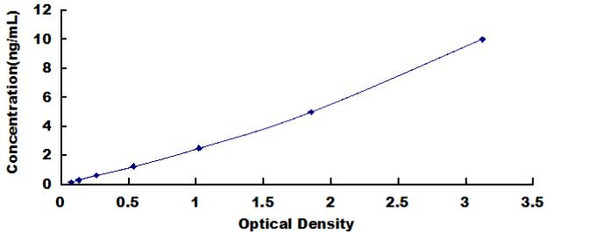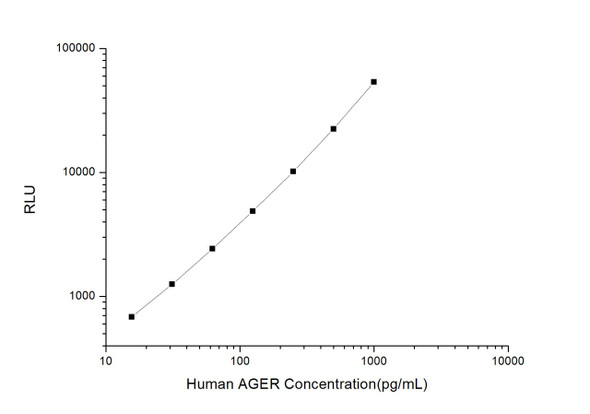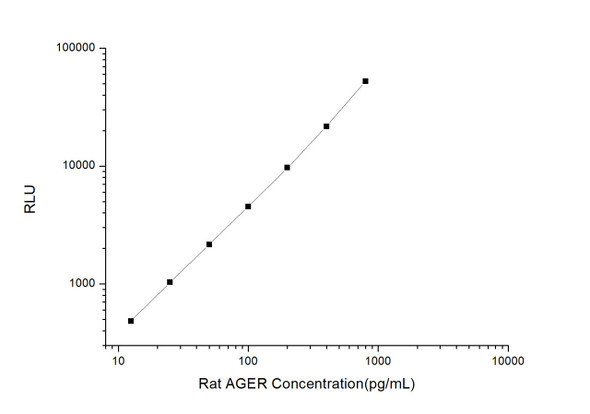Mouse Immunology ELISA Kits
Mouse AGER (Advanced Glycosylation End Product Specific Receptor) CLIA Kit (MOES00096)
- SKU:
- MOES00096
- Product Type:
- ELISA Kit
- ELISA Type:
- CLIA Kit
- Size:
- 96 Assays
- Sensitivity:
- 18.75pg/mL
- Range:
- 31.25-2000pg/mL
- ELISA Type:
- Sandwich
- Synonyms:
- RAGE
- Reactivity:
- Mouse
- Sample Type:
- Serum, plasma and other biological fluids
- Research Area:
- Immunology
Description
| Assay type: | Sandwich |
| Format: | 96T |
| Assay time: | 4.5h |
| Reactivity: | Mouse |
| Detection method: | Chemiluminescence |
| Detection range: | 31.25-2000 pg/mL |
| Sensitivity: | 18.75 pg/mL |
| Sample volume: | 100µL |
| Sample type: | Serum, plasma and other biological fluids |
| Repeatability: | CV < 15% |
| Specificity: | This kit recognizes Mouse AGER in samples. No significant cross-reactivity or interference between Mouse AGER and analogues was observed. |
This kit uses Sandwich-CLIA as the method. The micro CLIA plate provided in this kit has been pre-coated with an antibody specific to Mouse AGER. Standards or samples are added to the appropriate micro CLIA plate wells and combined with the specific antibody. Then a biotinylated detection antibody specific for Mouse AGER and Avidin-Horseradish Peroxidase (HRP) conjugate are added to each micro plate well successively and incubated. Free components are washed away. The substrate solution is added to each well. Only those wells that contain Mouse AGER, biotinylated detection antibody and Avidin-HRP conjugate will appear fluorescence. The Relative light unit (RLU) value is measured spectrophotometrically by the Chemiluminescence immunoassay analyzer. The RLU value is positively associated with the concentration of Mouse AGER. The concentration of Mouse AGER in the samples can be calculated by comparing the RLU of the samples to the standard curve.
| UniProt Protein Function: | RAGE: Mediates interactions of advanced glycosylation end products (AGE). These are nonenzymatically glycosylated proteins which accumulate in vascular tissue in aging and at an accelerated rate in diabetes. Acts as a mediator of both acute and chronic vascular inflammation in conditions such as atherosclerosis and in particular as a complication of diabetes. AGE/RAGE signaling plays an important role in regulating the production/expression of TNF- alpha, oxidative stress, and endothelial dysfunction in type 2 diabetes. Interaction with S100A12 on endothelium, mononuclear phagocytes, and lymphocytes triggers cellular activation, with generation of key proinflammatory mediators. Interaction with S100B after myocardial infarction may play a role in myocyte apoptosis by activating ERK1/2 and p53/TP53 signaling. Receptor for amyloid beta peptide. Contributes to the translocation of amyloid-beta peptide (ABPP) across the cell membrane from the extracellular to the intracellular space in cortical neurons. ABPP-initiated RAGE signaling, especially stimulation of p38 mitogen-activated protein kinase (MAPK), has the capacity to drive a transport system delivering ABPP as a complex with RAGE to the intraneuronal space. Interacts with S100B, S100A1 and APP. Interacts with S100A12. Endothelial cells. 4 isoforms of the human protein are produced by alternative splicing. |
| UniProt Protein Details: | Protein type:Receptor, misc. ; Motility/polarity/chemotaxis; Membrane protein, integral; Cell cycle regulation Cellular Component: extracellular space; cell surface; cell soma; membrane; axon; cytoplasm; plasma membrane; integral to membrane; basal plasma membrane; cytosol Molecular Function:identical protein binding; protein binding; advanced glycation end-product receptor activity Biological Process: positive regulation of JNK activity; positive regulation of apoptosis; negative regulation of collagen biosynthetic process; positive regulation of smooth muscle cell proliferation; negative regulation of cell adhesion; JAK-STAT cascade; positive regulation of smooth muscle cell migration; induction of positive chemotaxis; activation of NF-kappaB transcription factor; calcium ion homeostasis; positive regulation of fibroblast proliferation; negative regulation of protein amino acid phosphorylation; regulation of DNA binding; positive regulation of neuron apoptosis; regulation of inflammatory response; negative regulation of endothelial cell proliferation; response to hypoxia; positive regulation of protein amino acid phosphorylation; inflammatory response; positive regulation of phagocytosis, engulfment; neurite development; positive regulation of autophagy; positive regulation of cell migration; positive regulation of inflammatory response |
| UniProt Code: | Q62151 |
| NCBI GenInfo Identifier: | 2497318 |
| NCBI Gene ID: | 11596 |
| NCBI Accession: | Q62151. 1 |
| UniProt Related Accession: | Q62151 |
| Molecular Weight: | 42,669 Da |
| NCBI Full Name: | Advanced glycosylation end product-specific receptor |
| NCBI Synonym Full Names: | advanced glycosylation end product-specific receptor |
| NCBI Official Symbol: | Ager |
| NCBI Official Synonym Symbols: | RAGE |
| NCBI Protein Information: | advanced glycosylation end product-specific receptor; advanced glycation end-products receptor; receptor for advanced glycosylation end products; receptor for advanced glycation end-products variant 20 |
| UniProt Protein Name: | Advanced glycosylation end product-specific receptor |
| UniProt Synonym Protein Names: | Receptor for advanced glycosylation end products |
| Protein Family: | Advanced glycosylation end product-specific receptor |
| UniProt Gene Name: | Ager |
| UniProt Entry Name: | RAGE_MOUSE |
As the RLU values of the standard curve may vary according to the conditions of the actual assay performance (e. g. operator, pipetting technique, washing technique or temperature effects), the operator should establish a standard curve for each test. Typical standard curve and data is provided below for reference only.
| Concentration (pg/mL) | RLU | Average | Corrected |
| 2000 | 51652 59790 | 55721 | 55693 |
| 1000 | 22013 25935 | 23974 | 23946 |
| 500 | 11745 10319 | 11032 | 11004 |
| 250 | 5087 5501 | 5294 | 5266 |
| 125 | 2810 2406 | 2608 | 2580 |
| 62.5 | 1338 1284 | 1311 | 1283 |
| 31.25 | 628 720 | 674 | 646 |
| 0 | 28 28 | 28 | -- |
Precision
Intra-assay Precision (Precision within an assay): 3 samples with low, mid range and high level Mouse AGER were tested 20 times on one plate, respectively.
Inter-assay Precision (Precision between assays): 3 samples with low, mid range and high level Mouse AGER were tested on 3 different plates, 20 replicates in each plate.
| Intra-assay Precision | Inter-assay Precision | |||||
| Sample | 1 | 2 | 3 | 1 | 2 | 3 |
| n | 20 | 20 | 20 | 20 | 20 | 20 |
| Mean (pg/mL) | 90.96 | 198.09 | 856.22 | 89.37 | 211.40 | 804.81 |
| Standard deviation | 9.21 | 17.21 | 84.42 | 9.87 | 20.21 | 75.17 |
| C V (%) | 10.13 | 8.69 | 9.86 | 11.04 | 9.56 | 9.34 |
Recovery
The recovery of Mouse AGER spiked at three different levels in samples throughout the range of the assay was evaluated in various matrices.
| Sample Type | Range (%) | Average Recovery (%) |
| Serum (n=5) | 96-110 | 102 |
| EDTA plasma (n=5) | 93-107 | 99 |
| Cell culture media (n=5) | 89-103 | 95 |
Linearity
Samples were spiked with high concentrations of Mouse AGER and diluted with Reference Standard & Sample Diluent to produce samples with values within the range of the assay.
| Serum (n=5) | EDTA plasma (n=5) | Cell culture media (n=5) | ||
| 1:2 | Range (%) | 87-101 | 93-107 | 96-111 |
| Average (%) | 92 | 100 | 102 | |
| 1:4 | Range (%) | 94-105 | 97-112 | 101-117 |
| Average (%) | 100 | 105 | 108 | |
| 1:8 | Range (%) | 87-101 | 90-103 | 92-103 |
| Average (%) | 92 | 95 | 98 | |
| 1:16 | Range (%) | 94-109 | 90-102 | 97-110 |
| Average (%) | 100 | 95 | 104 |
An unopened kit can be stored at 4°C for 1 month. If the kit is not used within 1 month, store the items separately according to the following conditions once the kit is received.
| Item | Specifications | Storage |
| Micro CLIA Plate(Dismountable) | 8 wells ×12 strips | -20°C, 6 months |
| Reference Standard | 2 vials | |
| Concentrated Biotinylated Detection Ab (100×) | 1 vial, 120 µL | |
| Concentrated HRP Conjugate (100×) | 1 vial, 120 µL | -20°C(shading light), 6 months |
| Reference Standard & Sample Diluent | 1 vial, 20 mL | 4°C, 6 months |
| Biotinylated Detection Ab Diluent | 1 vial, 14 mL | |
| HRP Conjugate Diluent | 1 vial, 14 mL | |
| Concentrated Wash Buffer (25×) | 1 vial, 30 mL | |
| Substrate Reagent A | 1 vial, 5 mL | 4°C (shading light) |
| Substrate Reagent B | 1 vial, 5 mL | 4°C (shading light) |
| Plate Sealer | 5 pieces | |
| Product Description | 1 copy | |
| Certificate of Analysis | 1 copy |
- Set standard, test sample and control (zero) wells on the pre-coated plate and record theirpositions. It is recommended to measure each standard and sample in duplicate. Note: addall solutions to the bottom of the plate wells while avoiding contact with the well walls. Ensuresolutions do not foam when adding to the wells.
- Aliquot 100µl of standard solutions into the standard wells.
- Add 100µl of Sample / Standard dilution buffer into the control (zero) well.
- Add 100µl of properly diluted sample (serum, plasma, tissue homogenates and otherbiological fluids. ) into test sample wells.
- Cover the plate with the sealer provided in the kit and incubate for 90 min at 37°C.
- Aspirate the liquid from each well, do not wash. Immediately add 100µL of BiotinylatedDetection Ab working solution to each well. Cover the plate with a plate seal and gently mix. Incubate for 1 hour at 37°C.
- Aspirate or decant the solution from the plate and add 350µL of wash buffer to each welland incubate for 1-2 minutes at room temperature. Aspirate the solution from each well andclap the plate on absorbent filter paper to dry. Repeat this process 3 times. Note: a microplatewasher can be used in this step and other wash steps.
- Add 100µL of HRP Conjugate working solution to each well. Cover with a plate seal andincubate for 30 min at 37°C.
- Aspirate or decant the solution from each well. Repeat the wash process for five times asconducted in step 7.
- Add 100µL of Substrate mixture solution to each well. Cover with a new plate seal andincubate for no more than 5 min at 37°C. Protect the plate from light.
- Determine the RLU value of each well immediately.






